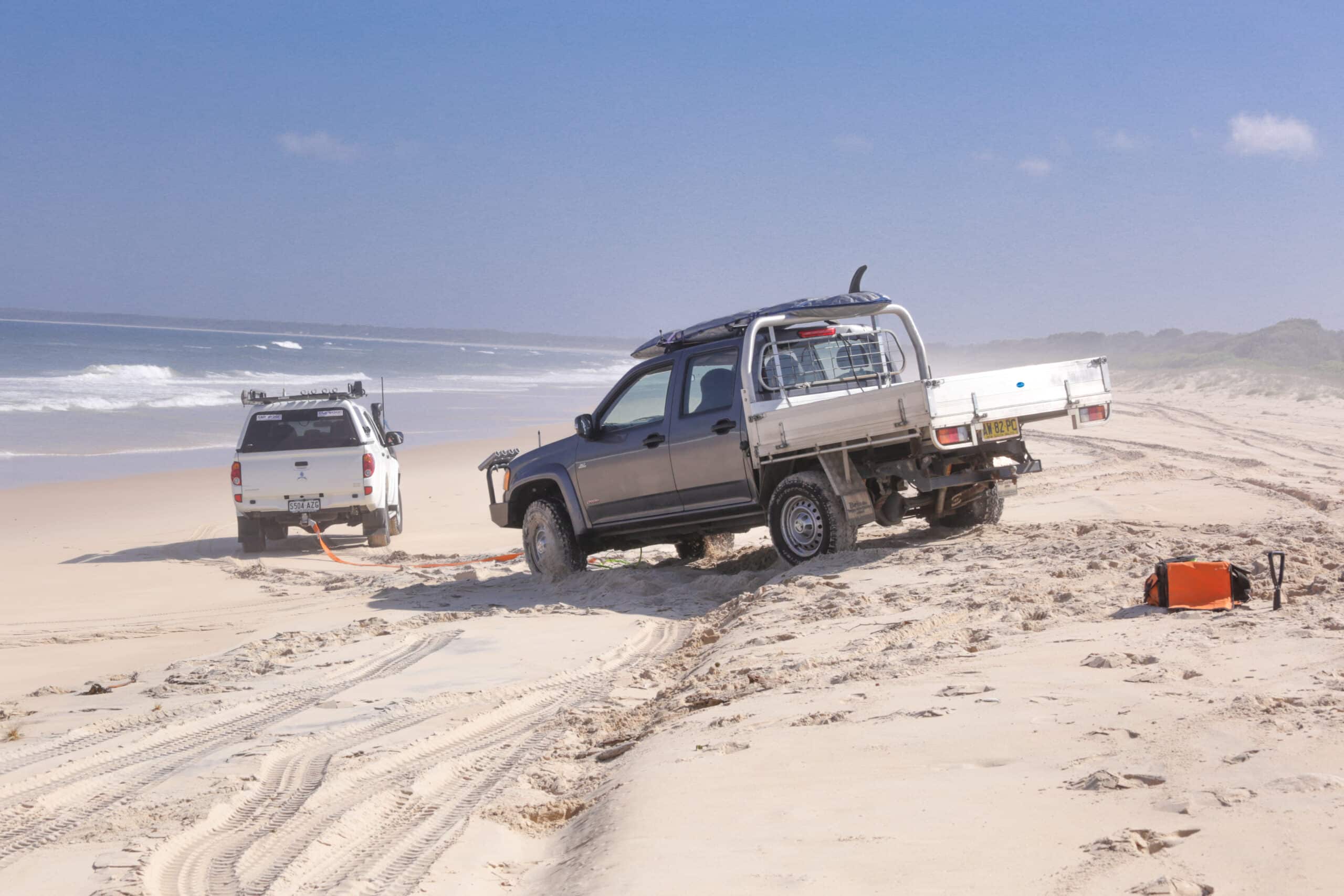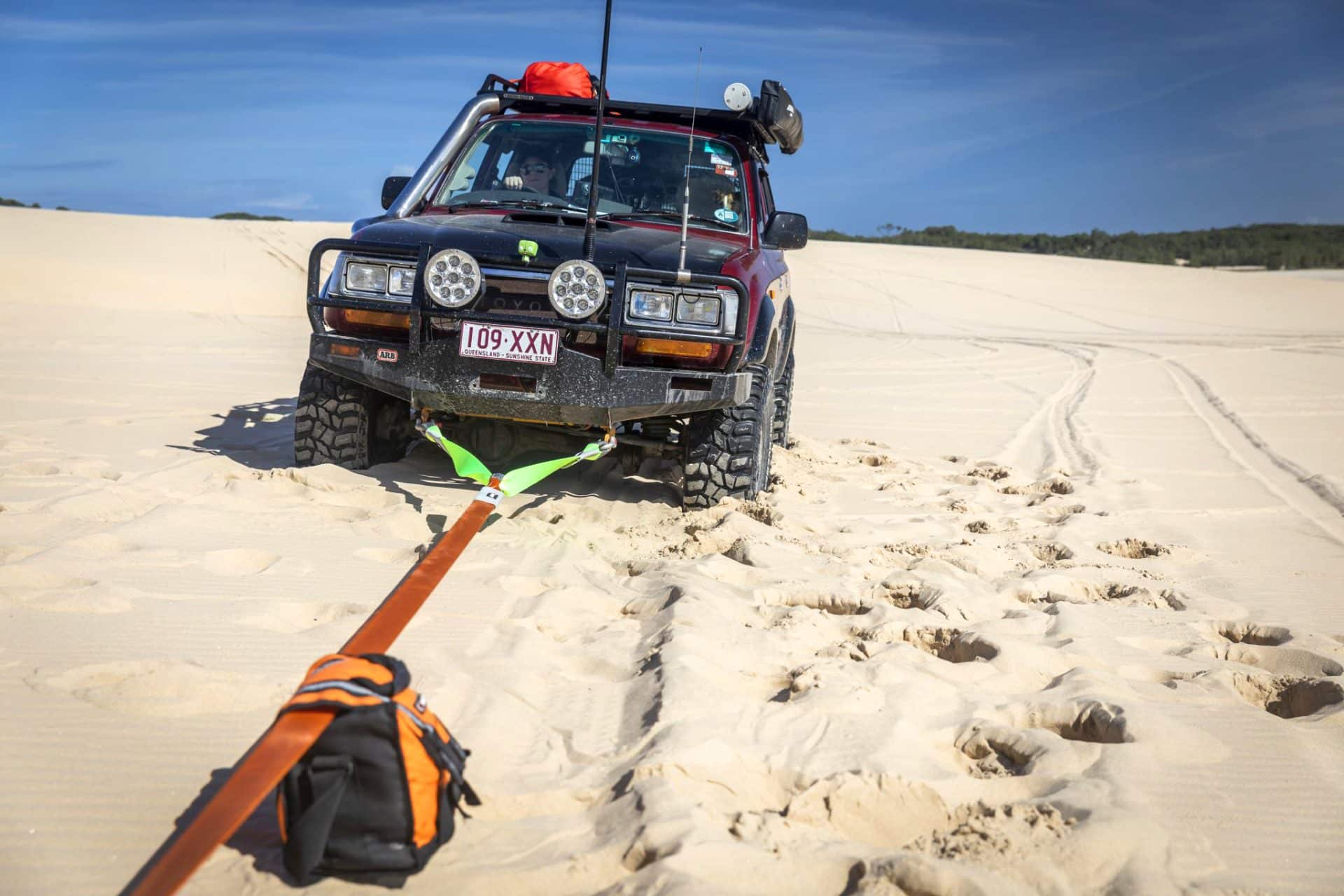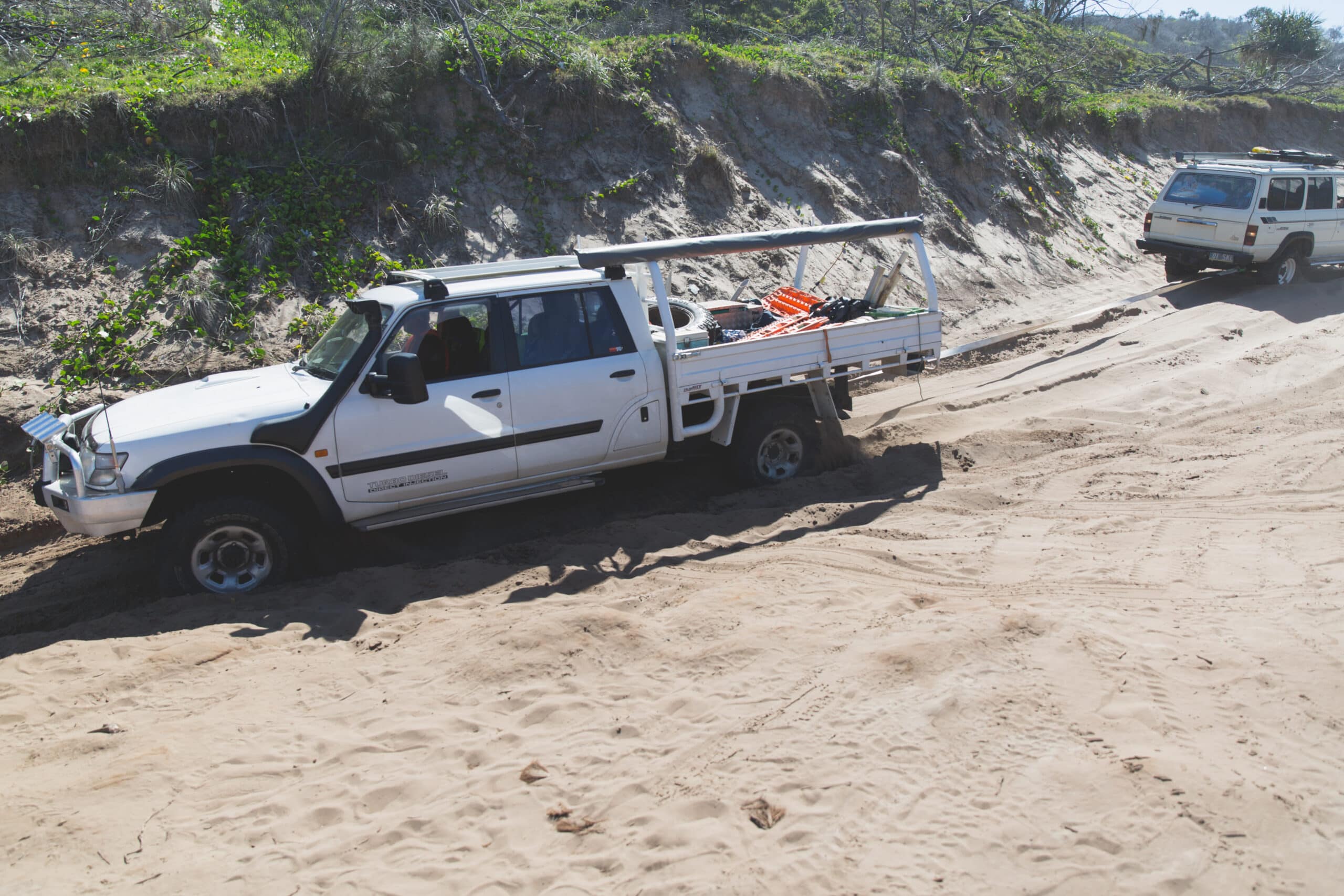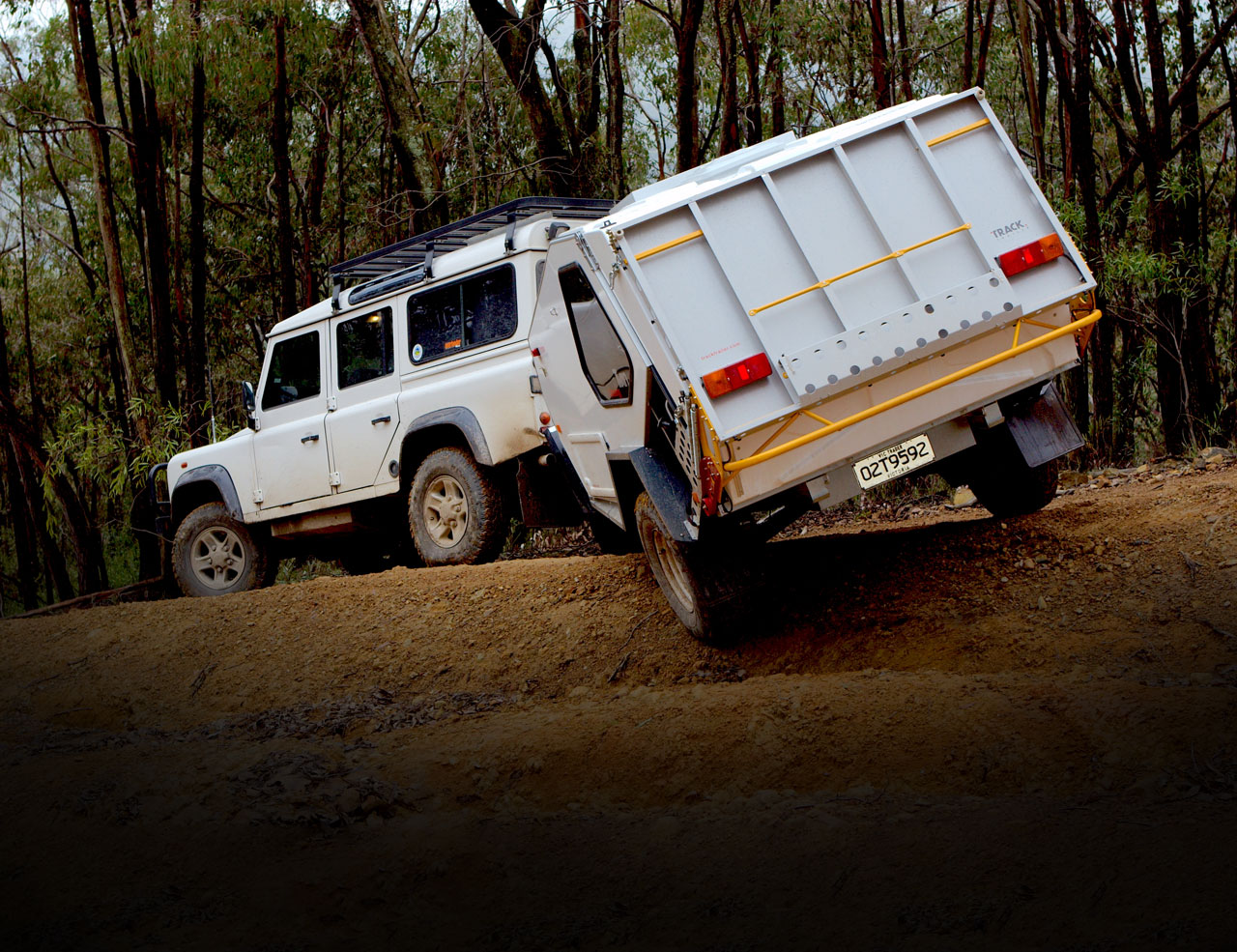Snatch straps and recovery kits go together like summer arvo’s and BBQs with good mates. They’re a fantastic invention capable of un-stucking the most stuck 4×4 and let pint-sized Jimny’s go toe-to-toe with Hummers. But they can ruin your day in ways inappropriate to discuss in polite places like the internet. With that in mind we’ve put together a pocket book guide with everything you need to know to be the snatch master. Most recovery kits will contain either one or two straps, and all the needed hardware and attachments to use them; including a good pair of gloves. But snatch straps do eventually wear out (we will get to that later); and you may wish to purchase another spare one.
When buying a snatch strap it’s important to know how much your loaded vehicle weighs … and then ignore that and buy the next one up. What are we on about we hear you yell? Well the ‘polite’ rule of snatching is ‘if you’re the one that needs recovering, your own snatch strap is used’. Makes sense to buy a strap to suit your vehicle right? Things don’t always go to plan though, which brings us to our next point.
You will invariably come across some poor sod bellied out on the low tide mark, and he won’t have one. Nobody with half a heart is going to leave him there … even if he does weigh a tonne more than your vehicle does. Unless, that is, he doesn’t have a suitable recovery point and you value your life … in that case, the kindest thing to do is grab a shovel and help him dig; or grab the Maxtrax.

HOW DO THEY WORK?
A snatch strap is a length of nylon webbing with loops (or eyelets) at both ends; they work by using kinetic energy to ‘pop’ a vehicle out of a bogging situation. They’re generally around nine metres long and come in various breaking strains – similar to a load rating on a cable. Whilst most ‘pre-packed’ recovery kits come with the highest rated straps, do double check.
The best straps are made from 100 per cent nylon, as polyester does not hold the same stretch and snap back properties. They work by the use of kinetic energy – think of it like stretching a rubber band and then letting go of one end, in essence a slingshot effect – and can stretch under load by around a metre of so. This may not sound like much, but the energy stored is enough to recovery most vehicles out of bogging situations.
Do not ever use a snatch strap as part of a winching operation, to tow a vehicle, or in circumstances where intricate recovery moments are required … and never use them to pull out something like a tree stump unless you want one imbedded in your back window. Their stretching properties can be dangerous when not used in the correct manner; and it is also for this reason they should NEVER be connected to a non-rated recovery point and especially never a towball. The power in a rebounding snatch strap can tear off a tow ball and launch it at high speed … and right in through the windscreen like a missile. People have been killed or seriously injured this way. This is also why a cable damper is used in all snatch strap recoveries.

SNATCH STRAP RECOVERY
Before you do any recovery with a snatch strap, ensure both vehicles have rated recovery points. If one vehicle doesn’t then you are safer trying to dig it out, road-build, or grab your Maxtrax – it’s not worth the danger of shackles whizzing through the air. If both vehicles are okay:
Prior to reaching for the strap, conduct a visual inspection of the bogging. Look at what is stopping the vehicle (it will be either traction or ground clearance). If ground clearance is the issue (i.e. the vehicle is ‘bottoming out’), grab a long-handled shovel and move away the mud/dirt, snow, log or rocks. Likewise, it’s a good idea to clear a track ahead of the wheels to make forward (or rearward) progress easier. All of this preparation ensures that less stress will be placed on the recovery points and on the snatch strap, making for a far safer recovery.
Unroll the snatch strap between the two vehicles to ensure there is enough length. If it’s too short, reverse the recovery vehicle back closer. You are looking at 2-3 metres of slack with the vehicles as in-line as possible. Do a final check to ensure there are no twists in the snatch strap.
Attach the strap to the two vehicles by using a rated bow-shackle through the eyelets at either end. The bow of the shackle should be against the recovery point, with the strap eyelet lying against the pin.
Tighten the pin, then back it off half a turn; this prevents the pin binding in the shackle and making it impossible to remove.
Note: Make sure the bow shackle is rated to suit the weight of the vehicle. This rating, also classed as a Working Load Limit (WLL), should be stamped on the outside edge of the shackle. Hardware store ‘D-shackles’ are not rated and can fail and turn into lethal projectiles.
Place a cable damper over the middle section of the snatch strap.
All bystanders should be well out of the way.
Ensure that both vehicles involved in the recovery are able to communicate via UHF – timing is crucial in this type of recovery.
If a third person is able to coordinate, have them also in radio contact but standing well out of the way and off to the side.
TIME TO ROCK AND ROLL
The recovery vehicle drives slowly forward until the second vehicle can advise that all the slack has been taken up in the strap. Do NOT step over a snatch strap that is under tension.
Before any recovery is done, both drivers need to ensure – and this goes without saying – that they are both wearing their seatbelts. The force of the rebound can throw an unsuspecting driver into the steering wheel if they aren’t strapped in.
The stuck vehicle should be in first gear low range (in idle, clutch in if a manual) and ready to drive out.
The recovery vehicle will move forward in low-range second gear at the ‘all ready, go’ signal of the driver in the bogged vehicle, via radio or hand signal. Excessive speed is dangerous, go as slow as you can but fast enough to give the snatch strap a chance to rebound.
The driver of the stuck vehicle should release the clutch and/or drive forward when they feel the jerk of the snatch strap pulling them. The vehicle will literally ‘pop’ out of the bogging.
Once the vehicle is free and able to drive forward, both vehicles can stop and be disconnected from the snatch strap.
If the vehicle does not come out after the first attempt, do not simply attempt another recovery at higher speed. Instead, re-evaluate the stuck vehicle, and attempt to remove the obstacles that may be in its way. Also consider lowering tyre pressures on the stuck vehicle to give it more traction. Faster recoveries merely increase the ‘shock load’ on the recovery points. It’s this momentary spike in the load that causes the most damage.

After the recovery
If the snatch strap is still clean, inspect its length for nicks, and stretch marks. A strap has a ‘snatch-life’ and once it has any damage or indicators of stretch damage, it needs to be replaced. If all is okay, roll it up and put it back in your recovery bag. If it is dirty and caked in mud, you’ll need to clean it; so pop it in a plastic bag, give it a good hosing when you get it home and drape it over your clothesline until completely dry. Never pack away a wet snatch strap, as they can rot.
Quick Links
10 Recovery Mistakes You Need To Stop Making
Snatch Strap Destruction Test








